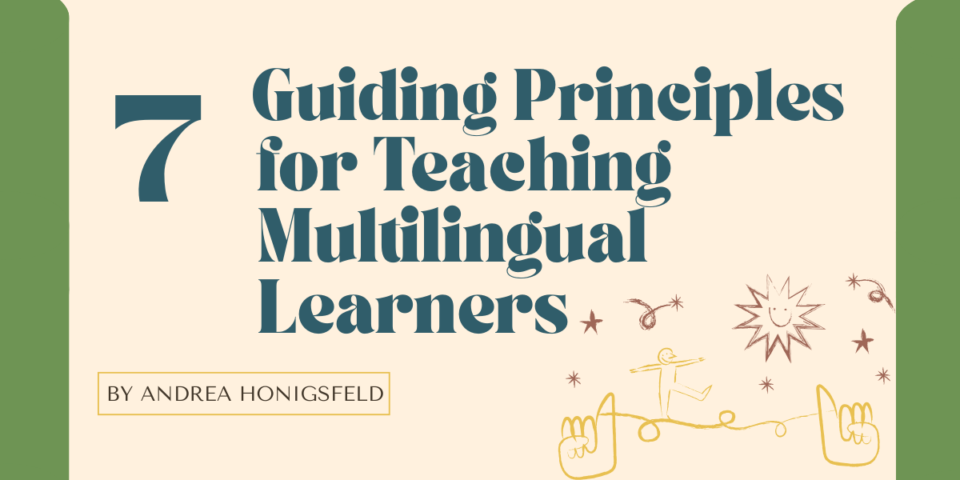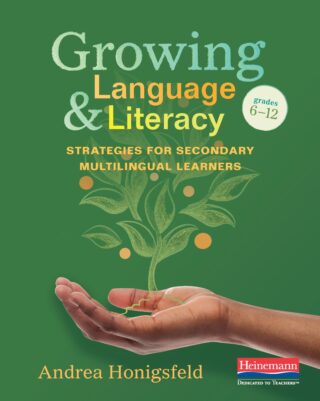
Seven Basic Tenets of Teaching Multilingual Learners (pp. xvii-xxi)
This blog is adapted from Andrea Honigsfeld’s forthcoming Growing Language and Literacy for Secondary Learners.
Focusing on what students can do, as opposed to what they cannot do, is much more likely to make students feel empowered and able to learn English. Too often, discussions of multilanguage learners (MLs) are framed by a deficit model that insists students are at an academic disadvantage because of their cultural, social, and linguistic backgrounds, including their lack of or limited ability to communicate in English. In contrast, an assets-based model of education considers and intentionally builds upon the values, lived experiences, language patterns, and background knowledge students bring and sees them as strengths and advantages that support, not hinder, learning.
Assets-Based Philosophy
We must recognize multilingual learners and their rich cultural and linguistic backgrounds as social and educational resources for everyone in a school community. Instead of looking at MLs as deficient and lacking knowledge and skills, take a strengths-based approach to understanding what each student is able to do and how to support them to reach their full potential. With an assets-based philosophy, you build on students’ experiences and deeply connect instruction to students’ and their families’ lives. What students can do will be treated as exactly what the students are supposed to do. We cannot remediate what has not been built yet!
Individual Variations
As a group, multilingual learners represent tremendous diversity—not only culturally, linguistically, and socioeconomically, but also based on how much prior knowledge and what type of academic, linguistic, and literacy skills they bring with them when they enter your classroom. Although language proficiency tests are commonly administered in each state to establish incoming students’ proficiency levels, it is important to understand that students’ trajectory and direction of development may be different in each of the four language domains. In speaking and listening, they may represent one level, and in reading and writing, a quite different one.
Although there are common patterns and predictable stages of language acquisition, MLs are unique individuals who move along the continuum of language learning at different rates. When you work with MLs, you notice that the progress students make week to week, or month to month, or year to year, varies. In addition, MLs may appear to have skills associated with more than one language or literacy development stage; for example, a student may be more advanced in speaking than in writing.
Student Agency, Autonomy, and Resilience
Multilingual adolescents must have every opportunity to develop into young adults who fully embrace their personal and educational agency, autonomy, and resilience. CASEL (2021) reminds us that, as educators, we have to expand our pedagogical knowledge and skills to include social-emotional growth. In our planning and lesson delivery for MLs, we must be intentional with SEL (social-emotional learning) so our students “develop healthy identities, manage emotions and achieve personal and collective goals, feel and show empathy for others, establish and maintain supportive relationships, and make responsible and caring decisions” (CASEL 2021). When we support our adolescent multilingual students’ agency, autonomy, and resistance, we support them in:
- using their agency to define both short-term and long-term academic, linguistic, and personal goals and to pursue those goals purposefully and successfully;
- using their autonomy to develop independence and respond to challenges and opportunities—be they academic, linguistic, or personal—by applying their gifts, talents, knowledge, and skills in new contexts; and
- using their resilience to learn to manage adverse academic, social, linguistic, and personal experiences and to develop coping mechanisms for facing obstacles in and outside the classroom.
Safe and Supportive Learning Environment
All students need a healthy and safe learning environment with trusting relationships in the classroom, in school, and in our larger communities not only to survive and manage but to thrive. This is especially true for multilingual adolescent learners. When we intentionally create a supportive learning environment for MLs by embracing their multilingualism and by creating warm, welcoming physical spaces, they can feel affirmed, seen, and heard. They can take more risks as language learners and develop a stronger sense of belonging.
Integrated Content, Language, and Literacy Instruction
Language and literacy learning for multilingual learners does not exist in isolation from the academic curriculum (WIDA 2020). Academic language is recognized as the language used in schools to acquire new or deeper understanding of the core curriculum and to communicate that understanding to others (Gottlieb and Ernst-Slavit 2014). Sarah Ottow (2023) argues for teachers to “think about and operationalize the academic language of our content through which to plan, teach and assess” (17). She refers to this as “developing a language lens,” emphasizing that not only will this lens “help us predict what challenges students may have, [but] it can also aid us in discovering opportunities to provide appropriate support and knowledge to plan explicit language goals” (18). With these notions in mind, we can introduce strategies that may be used across grade levels and content areas in support of developing academic language and literacy skills. Mark Pacheco, Shannon Daniel, and Lisa Pray (2017) suggest that “language and content are not separate, and as students engage with different disciplines, they learn to use language practices valued in that discipline” (75). We must see language as a path to equity and an integral part of whatever content we teach (Nordmeyer et al. 2021).
Culturally and Linguistically Sustaining Instructional and Assessment Practices
In a seminal essay, Django Paris (2012) carefully differentiates between culturally responsive (Ladson-Billings 2011) and culturally proficient philosophies and argues that students need culturally and linguistically sustaining instruction and assessment. Among so many other practitioners and scholars, more recently, Carla España and Luz Yadira Herrera (2020) have reminded us to understand, honor, celebrate, and elevate bilingual students’ experiences. Teachers who engage in these practices not only recognize and respond to students’ languages, literacies, and cultural practices but also validate them through multimodal and multilingual learning opportunities. “Rather than framing students’ uses of [their home languages] as markers of deficiency, teachers can recognize, praise, and investigate student language use to inform classroom meaning-making” (Pacheco et al. 2019, 77).
Purposeful Interaction and Collaboration
Language and literacy development as well as content attainment require students to interact not just with the academic content and their teachers but with each other as well (Zwiers 2019). In the social-constructivist tradition, we must recognize that language does not thrive without ample opportunities to participate in meaningful learning activities that require collaboration.



